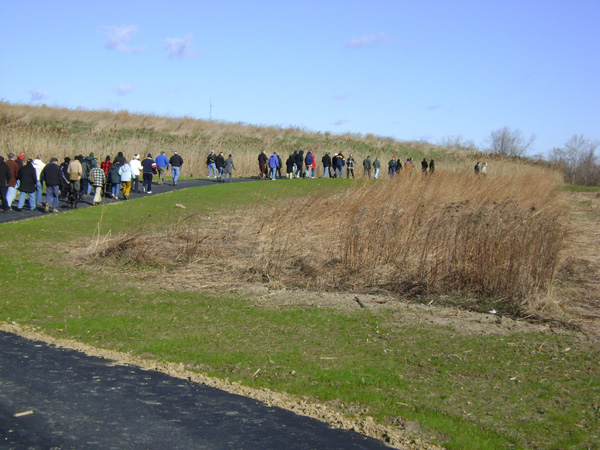Pennypack on the Delaware Park is open

Nov. 22
By John Davidson
For PlanPhilly
Icy winds and near-freezing temperatures couldn’t keep dozens of waterfront trail enthusiasts, including Mayor Michael Nutter, from the opening of the new riverfront nature trail at Pennypack on the Delaware Park. If turnout for the frigid ribbon cutting ceremony on Saturday morning was a sign of things to come, the new trail will see heavy use come springtime’s warmer weather.
The wide paved trail winding north from the park to Pennypack Creek is the first completed step of the Greenway Plan for the North Delaware, which aims to transform former industrial sites along the river into a trail and park system that extends 11 miles between Pulaski Park in Port Richmond and the Glen Foerd Mansion in Torresdale.
Although the new trail only goes as far as Pennypack Creek, where it meets the Delaware River, plans are already drawn up for a bridge over the creek and trails extending north.
South of the park, the Greenway Plan calls for waterfront trails all the way to Allegheny Avenue, where they could connect with an ambitious master plan laid out in the Civic Vision and Action Plan for the Central Delaware Riverfront earlier this year. That plan envisions trails stretching from Center City to Penn Treaty Park in Fishtown and eventually connecting to the newly completed nature trail at Pennypack, which planners are looking to as a model.
One glance at the nature trail and it’s clear that city planners have envisioned more than mere trails for the riverfront.
The paved lane winds lazily around an elevated mound to the left and grassy wetlands to the right, with a smaller paved path branching off through tall grass that leads to a viewing platform on the river surrounded by a stand of trees.
“This is also about restoring the riverbank and restoring the river’s edge as a part of the greenway,” said Sarah Thorp, executive director of the Delaware River City Corporation, one of the organizations driving development. “It’s not just about putting down a trail.”
Mark Jendrezewski, landscape architect for the nature trail, said he designed the path to meander in a way that draws you forward.
“The trail design is taking advantage of the many unique situations that appear on the site,” he says. “There’s the mound, the meadow, riparian buffer, the created wetlands, the mitigated wetlands and eventual stream crossing for the Pennypack.”
The trail itself lazily curves to and away from these landmarks, disappearing and reappearing as you walk.
“The purpose of the curved trail is to keep drawing you further into the trail,” Jendrezewski says. “Each bend brings you point by point to the individual sites—the mitigated wetlands, the mound—which are interesting features.”
Like many city parks, Pennypack is tucked away from view, hidden behind a prison complex and I-95. If you were driving down State Road you might not know there’s a park along the river, let alone a new system of trails being built there.
But Nutter, who was on hand along with DCNR Secretary Michael DiBerardinis, U.S. Rep. Allyson Schwartz and other officials, wants to change that—despite budget shortfalls and a struggling economy.
“We’ve been talking about the waterfront for about 40 or 50 years, so I think it’s about time we actually did something,” Nutter said during brief opening remarks.
“We’re looking to your leadership and the model that’s taken place here to get some stuff going all up and down the waterfront,” he said. “And this will be one of the signature projects for the city of Philadelphia. Fifty, a hundred years from now people will be thinking about how smart we all were to make this happen.”
Funding for the nature trail came from a mix of federal, state and city dollars, including a $1 million grant from the state Department of Conservation and Natural Resources to the Delaware River City Corporation. Some funding is also in place to begin work next year on Lardner’s Point Park at the foot of Tacony Palmyra Bridge that will connect with a bike trail along the former Kensington-Tacony rail line.
Thorp says it’s part of a sweeping vision to connect all the Delaware riverfront trails with the East Coast Greenway, a 3,000-mile trail system between Maine and Florida. If all goes according to plan, Philadelphia will one day boast 18 miles of the interstate greenway running along the Delaware River.
“We’re excited that our trail is eventually going to go to Center City, so people will be able to get on the trail down there, bike all the way up here to the Northeast and then eventually continue on through Bucks County and go to Maine,” Thorp says.
One challenge currently facing planners is how to get a trail connection through the Conrail site at Allegheny Avenue to link up Pennypack’s trail system with Delaware Avenue and Penn Treaty Park in Fishtown.
But for now, plans are in place to finish trails extending south from Pennypack to Allegheny Avenue within the next four years, according to Thorp.
“You want to have a trail that’s diverse,” she says. “You want to have areas that are urban, you want to have amenities like a coffee shop and a café, but then you want the trail to go into areas that are more natural, like this, so you can see the diversity of Philadelphia’s riverfront, which is really amazing.”
Contact the reporter at jddavidson9@gmail.com
WHYY is your source for fact-based, in-depth journalism and information. As a nonprofit organization, we rely on financial support from readers like you. Please give today.



